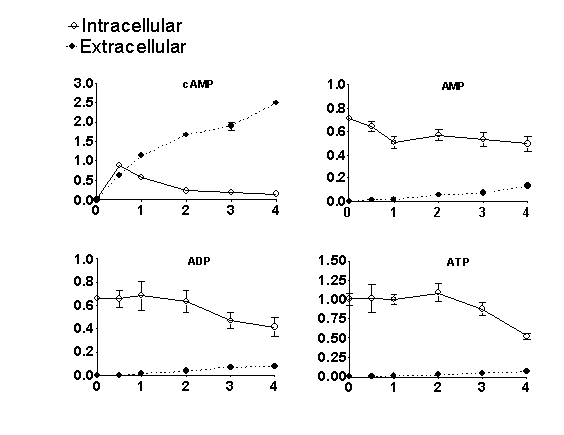| pA2 online © Copyright 2004 The British Pharmacological Society |
114P
University of Newcastle Winter Meeting December 2004 |
Isoprenaline-stimulated efflux of endogenous cAMP and other adenine nucleotides from CHO cells expressing the human β2-adrenoceptor Rebecca L Cordell1,2, David A Barrett2 & Stephen J Hill1, Institute of Cell Signall H. |
|
We have previously shown that isoprenaline can stimulate export of 3H-cAMP from 3H-adenine-labelled CHO cells expressing the human β2-adrenoceptor (CHO- β2 cells; Baker et al., ing1 and School of Pharmacy2, University of Nottingham, Queen’s Medical Centre, Nottingham, NG7 2U2004). Liquid chromatography-mass spectrometry (LC-MS) allows the simultaneous detection of multiple metabolites in cell systems, and is a sensitive and highly specific technique (Tuytten et al., 2002). In this study, LC-MS was used to study the effects of isoprenaline on the intracellular levels and export of adenine nucleotides following β2-adrenoceptor stimulation.
CHO cells expressing the human β2–adrenoceptor were grown to confluence in 6-well plates as described previously (Baker et al., 2004). The cells were then stimulated for 4 hours with isoprenaline (10 µM) in 1 ml serum free DMEM-F12 media per well. To measure extracellular nucleotides the media was removed at 0.5, 1, 2, 3 and 4 hours. To measure intracellular nucleotides 1 ml methanol (precooled to -20 °C) per well was added after media removal. Cellular debris was removed by centrifugation and the samples were then evaporated to dryness under nitrogen and dissolved in water (100 µl for extracellular samples and 50 µl for intracellular samples). 50 µl (extracellular) or 25 µl (intracellular) of these samples were then subjected to LC-MS analysis using a modified published method (Tuytten et al., 2002).
cAMP, AMP, ADP, ATP were detected in both intracellular and extracellular samples. The effect over time of isoprenaline (10 µM) on the levels of these nucleotides can be seen in the Figure. cAMP increased rapidly intracellularly over the first 0.5 hours and then began to decrease. In contrast, extracellular cAMP increases rapidly and continues to increase over the 4 hour time period. AMP, ADP and ATP all showed slight decreases intracellularly but accumulated extracellularly over time. Adenine and adenosine, however, could not be detected in either intracellular or extracellular samples.

Figure. The effect of isoprenaline on cAMP, AMP, ADP and ATP levels. Data points represent mean + SEM of 9 repeats from 3 separate experiments. The ordinate is expressed as the peak area of the sample relative to that obtained with a 10 µl injected sample of a 10 µM standard (cAMP, AMP, ADP or ATP).
The transport of cAMP out of cells and its possible hydrolysis to adenosine has been previously described (Rosenberg et al., 1995, Brundege et al., 1997). In this study we show that cAMP is the major adenine nucleotide exported from CHO- β2 cells in response to isoprenaline and that there is little evidence for the presence of substantial quantities of extracellular AMP, ADP, ATP or adenosine.
Baker JG et al., (2004). Mol. Pharmacol. 65, 986-998.
Brundege JM, et al., (1997). Neuropharm. 36, 1201-1210.
Rosenberg PA & Li Y, (1995). Brain Research. 692, 227-232.
Tuytten R, et al., (2002). Rapid Commun.Mass Spectrom.16, 1205-1215.